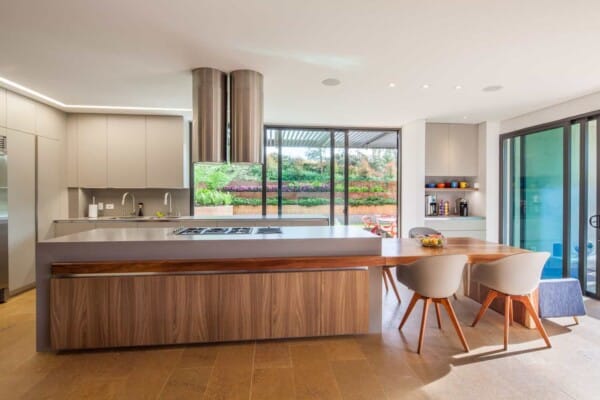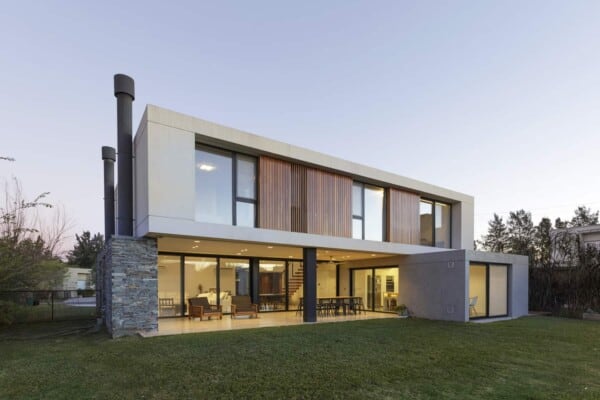Crone Partners Melbourne office has designed the Good Residence in Sandringham, a suburb in Melbourne, Victoria, Australia.
The project explores notions of achieving a highly glazed, modern inner suburban home that offered its inhabitants the option of passively controlling their living environment, whilst ticking off a demanding functional brief, seemed initially to be a substantial challenge.
The two-story home is a finalist in the 2011 Houses Awards for the New House over 200 square meters category.
The Good Residence by Crone Partners:
“Embracing the challenge of a relatively tight inner suburban location, and restrictive building envelope, the designers worked closely with the client to rationalise their “wish list” into a concise and deliverable brief. Little was lost in this process and even less in the translation to a finished home for the builder / client and their young family.
The house’s finely detailed bold rectilinear form is set back from the street amidst a carpet of natural ground cover. Entrance down the side of the house is made via a subtle path formed from old railway sleepers embedded into the ground. Whilst sitting comfortably in its street context proportionally, and with setbacks respectful of its neighbouring properties, the view from the street confirms immediately that this house is quite different to those around it.
The project is realised through a series of simple intersecting and overlapping rectangular forms. Each “box” represents a distinct portion of the overall program. A sleeping / study zone, a living zone, a garage / workshop, and cantilevered above all of this, a parents retreat, complete with its own living area and secluded outdoor terrace.
The forms of the building have been carefully articulated as both screening devices for privacy, and elements that frame and define views. The robust external cladding that changes appearance significantly in different weather and lighting conditions, gives way to a warm and welcoming interior, filled with natural light, high ceilings, double height voids and sensuous materials. Extensive use and clever placement of high performance double glazing draws light into every room. The line between interior and exterior is blurred, with banks of operable louvres and huge sliding glass panels presenting the family with the ability to engage directly with the outside environment, or to close the place down completely, dependant on the variable Melbourne climate.
Whilst not overtly “green” in appearance the house design is based on sound ESD principles. Ultimately the design is about handing control to the occupant through a solution that is highly interactive. The passive design solutions, and the options they provide, have resulted in a house that relies little on the active cooling and heating systems that have been installed. The designers deliberately pushed their exploration of the project form and aesthetic, whilst maintaining the highest level of sustainability. The initiatives incorporated into the design include:
- High performance tinted double glazing.
- Solid heavily insulated west façade with limited openings.
- Increased internal thermal mass to minimise diurnal temperature fluctuation.
- Floating Level 1 cantilever box provides shading from the north sun to the main living area
- Passive cooling via natural cross ventilation – the entire place can be opened up with a combination of large sliding glass panels and glazed louvres
- Double skin façade to the exposed east on Level 1 provides both visual privacy and excellent thermal control. The external skin is made up entirely of opaque glass louvres.
- 20,000 litre rain water storage tank below ground for reuse in toilet flushing and irrigation.
- Solar access to the feature lap pool has been maximised by aligning the building as close as possible to the south west boundary.
- Roof mounted solar heating for the pool.
- Underfloor slab heating to Ground Floor.
The house presents as a blank canvas, onto which the family inserts the detail of their ever changing lives. It provides flexibility for growth and change, with spaces that can be opened up and connected, or closed down for more restricted and intimate use. The primary living zone has been created to serve the clients specific needs for an interactive informal space that caters for the variance of their day to day lives. It flows effortlessly from one functional area to another and can be opened up to embrace the adjoining outdoor spaces, in particular the northerly orientated back yard and lap pool.”
Photos by: Derek Swalwell
Source: Contemporist













































